A plant like passionflower (Passiflora) is also called "cavalier star" or "passion flower". It is directly related to the genus of the passionflower family, in which 400-500 species of various plants are read. They can be found in nature in the tropical regions of America (Peru and Brazil), in Australia, Asia, and also in the Mediterranean. 1 species of passionflower can be seen in Madagascar. Passionflower is formed from the Latin words "passio" - suffering and "flos" - flower. So, the first missionaries who arrived in South America called the flower, since they believed that this plant is a symbol of the suffering of Jesus Christ. The second name "passion flower" is also associated with this:
That night when the blood of Christ was shed
(There is a legend about this among the people) -
For the first time he blossomed in the shadow of the cross
And therefore it is called passionflower.
Content
- 1 Description of passionflower
- 2 Passiflora care at home
- 3 Main types
- 3.1 Passionflower edible (Passiflora edulis)
- 3.2 Passionflower blue (Passiflora caerulea)
- 3.3 Passionflower tender (Passiflora mollissima)
- 3.4 Passionflower laurel (Passiflora laurifolia)
- 3.5 Passiflora incarnata
- 3.6 Passionflower (Passiflora gracilis)
- 3.7 Passiflora three-lane (Passiflora trifasciata)
- 3.8 Passiflora tetrahedral (Passiflora quadrangularis)
Description of passionflower
This flower can be both a herbaceous plant and an evergreen climbing shrub. This annual or perennial plant has woody shoots. Simple dark green leaves can be whole or lobed. On long pedicels, rather large axillary flowers of a star-shaped shape, having a bright color, grow. The diameter of such a very spectacular flower is 10 centimeters. Such a flower has exactly 5 petals (according to the number of wounds of Christ), the same number of sepals, there are rather large bracts, and in the center there is an ovary with 3 stigmas. Around these ovaries there are exactly 5 stamens with large anthers. In most species, flowers are very fragrant, but they fade relatively quickly. As a rule, bloom is observed in July – October. After flowering, fruits are formed, reaching a length of 6 centimeters. In most species, such fruits can be eaten. This plant grows very quickly and is not capricious, therefore it is quite popular among flower growers who grow it like ampelous.
Passiflora care at home
Illumination and placement
This plant just needs good lighting. Therefore, it is recommended to place it on the sill of a south-facing window.In the warm season, it (if possible) must be transferred to fresh air. The fact is that passionflower grows poorly and develops in a room with stuffy stagnant air. However, one should not forget that the plant reacts negatively to drafts or a sharp change in temperature.
Temperature regime
Passionflower reacts negatively to excessive heat. So, in the summer, try to keep the room temperature below 30 degrees. In winter, the plant has a dormant period, during which it must be rearranged to a place where the temperature will not exceed 10-14 degrees.
How to water
You need to water the plant systematically, while waiting for the soil to dry out. However, the excess liquid that is glass in the pan must be drained.
Humidity
High humidity is required. To do this, the foliage must be moistened daily from the sprayer in the evening, as well as once a week arrange a warm shower for the plant (only in the hot summer months), while this procedure is carried out very carefully so as not to damage the fragile shoots.
Pruning
It is necessary to carry out pruning annually. This stimulates the growth of both the bush itself and new branches. In spring, you should cut off 1/3 of last year's secondary stems, since flowers appear only on young shoots. Also, in the summer, you should remove the shoots that grow at the base of the plant. When the passionflower has faded, you will need to trim the long, bald secondary stems that spoil the appearance of the bush. The remaining stems should be cut to ¾ of their length. It is necessary to start trimming the bushes after the plant reaches 3 years of age.
Fertilizer
In the period from February to September, the plant must be regularly fed 2 times a month. To do this, use organic and mineral fertilizers while feeding them alternately. Fertilizers are applied only after preliminary moistening of the substrate. Fertilizer should be chosen with such a ratio of elements N-P-K = 10-5-20. It is recommended to feed the flower by foliar method 1 time in 1.5 months from April to September. You cannot fertilize a flower if it is sick, during a dormant period, or after it has been transferred to a place with unusual conditions.
Dormant period
For abundant and long-term flowering, the plant simply needs a rest period. To do this, the pot should be rearranged in a well-lit cool place, for example, in a warmed loggia or on a veranda. During this period, it is not necessary to supplement, fertilize or moisturize the flower. Watering should be sparse and infrequent. Do not worry if several leaves fall off, as this is quite normal. If it is impossible to provide the plant with a cool wintering, it cannot be transferred anywhere and is looked after, as in the warm season. However, in this case, most likely the foliage will turn yellow and begin to die off, and this is a completely natural process.
Growing features
For the shoots of this plant, it is necessary to provide a sufficiently strong support. In this case, you need to regularly direct the stems in the direction that you need. This must be done in a timely manner, because fast-growing shoots lignify at a relatively high rate, and a lot of leaves, buds and flowers significantly weigh them down and make them clumsy.
Transfer
Young specimens require an annual transplant, and adults need to be transplanted once every 2 or 3 years. This procedure is carried out at the beginning of the spring period and before that, all last year's stems are necessarily cut off. The planting container is not very large in size, which will provide long and abundant flowering. Otherwise, only the green mass will grow strongly. A suitable dredge consists of equal shares of leaf, turf and peat soil, as well as sand. It is necessary to transplant by the transshipment method, while trying not to destroy the earthen coma.
Diseases and pests
This plant can settle aphids, mealybugs, spider mites, thrips or whitefly... All insects except mealybugs can be exterminated by such means as Fitoverm, Aktellik or Aktar. Mealybugs will help get rid of means with cypermethrin, for example, "Emperor", "Arrivo" or "Inta-vir".
Passionflower is susceptible to various diseases, so, it can become infected with: ring, bacterial or brown spot, late blight, scab, root rot, fusarium or yellow mosaic virus. It is almost impossible to cure plants from such diseases. In this regard, experts recommend destroying it along with the container in which it grew in order to prevent infection of other flowers.
Properties
Humanity has long known about the medicinal properties of this plant. So, the Incas prepared tea with passionflower, which had a strong sedative effect. Means prepared from such a flower, gently affecting the body, make sleep better and longer, while after waking up, a person does not feel discomfort.
However, the plant has not only a sedative effect, it also relieves spasms and cramps, eliminates inflammation, is an excellent pain reliever, improves potency, memory and performance. Reception is recommended for nervousness and irritability. This flower is able to compensate for the effects of amphetamine on the body, therefore it is often used in the treatment of alcoholism and drug addiction.
This plant is also valued for the fact that preparations made from it do not have unwanted side effects, and they are also not addictive. They are used to treat people of any age.
Reproduction methods
Passionflower can be propagated by cuttings or seeds.
When sowing seeds, it should be borne in mind that freshly harvested ones have thirty percent germination, and last year's ones have only 1 or 2 percent. Sowing of seeds is carried out at the end of the winter beginning of the spring period. Scarification is required; for this, the seed shell is damaged with fine sandpaper. Then they are poured with lukewarm water (about 25 degrees) for 2 days. Seeds remaining floating should be removed as they are not germinable.
Seeds are sown on the surface of the soil and pressed a little into it. For germination, a moisture content of 100% is required. To do this, the container is covered with glass or film, placed in a well-lit place (diffused light) and the temperature is maintained at 20 to 25 degrees. After the seeds germinate, the shelter must be removed, and the seedlings will need additional lighting to create a daylight hours lasting 12 hours. After the appearance of real leaves, you need to pick. Try to leave the earthen lump intact and not bury the plant. Seedlings may appear 1–12 months after sowing, and such passionflower will begin to bloom no earlier than 8 years later.
Cuttings are made from young spring stems. They must have a growing point and at least 2 pairs of leaves. A couple of leaves from the bottom are cut off. Treat the cut with a root stimulating agent. A drainage layer is made in the container and black soil and sod soil are poured into it (1: 1). Make indentations with a pencil to the bottom of the container. Place the cuttings in them, so that the leaves remain above the ground (lay on the surface). Moisten the substrate and make a mini-greenhouse (cover the arched structure with foil or put on a plastic bag). We need daily five-minute ventilation, keeping the earth moist, and a temperature of 21 degrees. After 3 weeks, the shelter is removed. Fortified cuttings are transplanted into permanent pots. Rooting is also carried out in a jar of water (a piece of charcoal must be dipped into it). Place the cutting and wait for the roots to appear for about 1.5–2 months. Do not change the water.
Main types
Passionflower edible (Passiflora edulis)
This is the most popular type among florists. At home, this flower is called granadilla, and this is in Paraguay, Argentina, Uruguay and Brazil. The flowers are creamy white.Round or ovoid fruits are formed, reaching 6 centimeters in length and with a strong and pleasant smell. They are used to prepare drinks and various sweets. The better known name for this species is passion fruit.
Passionflower blue (Passiflora caerulea)
This plant is also quite often grown at home. It is an evergreen vine with woody shoots. During the flowering period, single fragrant flowers appear. They have a pale bluish-green or lilac color, and their diameter is about 10 centimeters. There are varieties in which the flowers are colored red or pinkish. The fruit is an orange berry reaching a length of 7 centimeters. This plant is found in the Andes (southern Argentina), in Paraguay, Brazil, and also in Peru. This species began to grow already in the 16th century.
Passionflower tender (Passiflora mollissima)
Or banana passionflower - found naturally in Colombia, Bolivia and Venezuela. It has pale pink large (12 centimeters in diameter) flowers. The fruits are fleshy and very fragrant; they contain a large number of organic acids. This species, unlike the others, is able to bear fruit abundantly already in the 1st year of life. This is a cold-resistant plant that is not afraid of a temperature drop to minus 2 degrees.
Passionflower laurel (Passiflora laurifolia)
Homeland is Brazil. The leaves of such a plant are similar to laurel, but they are larger.
Passiflora incarnata
Or meat-red passionflower, and it is also called an apricot vine - its length can be 6-10 meters. Flowers can be painted in different colors, but the most common color is purple. The lemon yellow fruits are quite tasty and have a slight sourness. This species has healing properties, so, from dried shoots and leaves, medicinal tea is prepared for insomnia, neurosis, epilepsy and other diseases.
Passionflower (Passiflora gracilis)
Homeland Brazil, this annual has cylindrical shoots, smooth broad-triangular ovate leaves, which are shallowly dissected into 3 lobes. There are single greenish-white flowers. The fruit is a multi-seeded berry colored red with a coral tint.
Passiflora three-lane (Passiflora trifasciata)
It is native to Peru and gets its name from the 3 purple stripes that are located on the obverse of the three-lobed leaves. The seamy side is red-violet. The shoots are ribbed, and the flowers are pale green or whitish yellow. In diameter, they reach 4 or 5 centimeters. The fruit is a round-shaped gray berry that reaches 2.5 centimeters in length. The plant of this species has a special aroma that is similar to lilac.
Passiflora tetrahedral (Passiflora quadrangularis)
It is the largest of all passionflower plants. Its stems can be up to 15 meters long. The oval-shaped leaves are colored deep green. The flowers are quite large, they reach 15 centimeters in diameter. The huge fruits reach 30 centimeters in length and have a very tasty, sweet and juicy pulp, as well as a fairly thick rind. However, at home, fruits are rarely formed. The plant of this type feels best in greenhouses.
In addition to the species mentioned, passionflower is grown at home: winged, scarlet, changeable, racemose and hybrid Imperatrice Eugenic, which has large bluish-pink flowers.


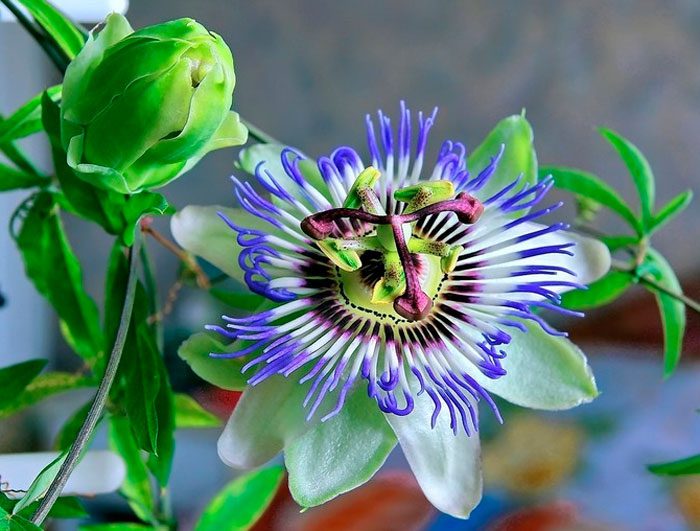


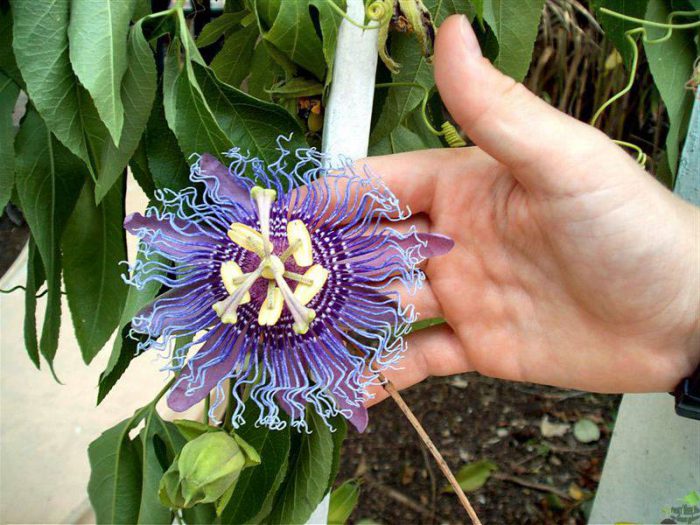



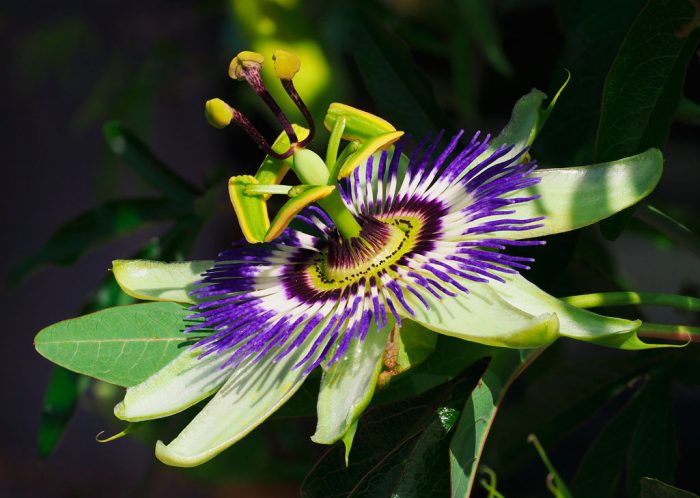

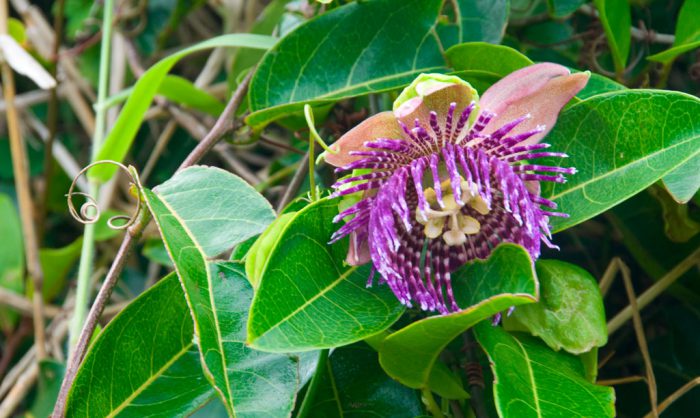
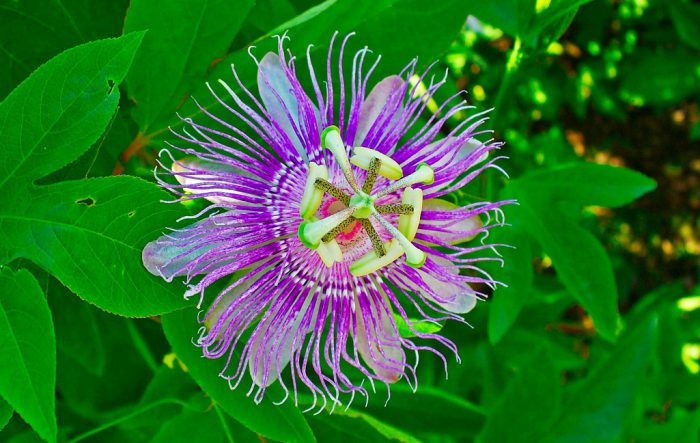


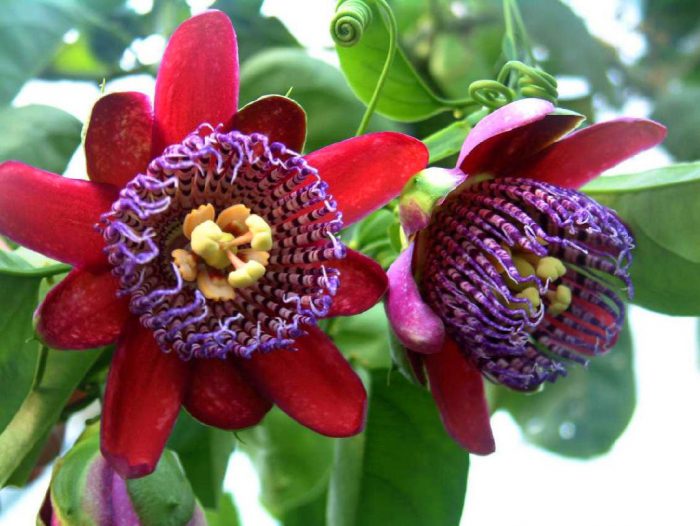










how are the fruits of passionflower consumed and with what